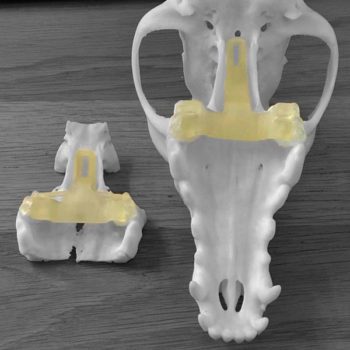27 Jan 2023
New approach funded by CVS Research Award will offer best clinical care for dogs with Cushing’s disease.

The anatomical placement of the 3D printed guide.
Two veterinary neurologists have helped develop a 3D printed guide to help improve brain surgery for dogs with Cushing’s disease.
Neurology clinicians Nicolas Granger and Leticia Escauriaza, based at Highcroft Veterinary Referrals, developed and assessed the design of a guide to aid a challenging procedure in any dogs with the common endocrine disease.
Transsphenoidal hypophysectomy surgery to remove a mass within the pituitary gland, which secretes cortisol and causes Cushing’s, is an advanced and challenging procedure because of the pituitary gland’s deep location below the brain.

In a study, funded by a CVS Clinical Research Award, Dr Granger and Mrs Escauriaza explored whether a 3D printed surgical guide, placed in the dog’s mouth, could aid neurosurgeons in locating the correct site of the pituitary with good accuracy.
They found it was possible to create a 3D printed guide from CT images, which accurately identified the exact location of the body cavity containing the gland. The resulting guide, developed in collaboration with Bill Oxley at Vet3D, is bespoke for each dog and locks on to its molar teeth.
The guides can also be used for acromegaly in cats.
Dr Granger, European and RCVS specialist in veterinary neurology (small animals) at Highcroft, and lead author on the study, said: “The 3D printed surgical guide research lends itself well to being performed in clinical practice. Only a few specialist UK centres offer hypophysectomy, which can be used for Cushing’s disease in dogs and acromegaly in cats.
“Testing the 3D printed guide was natural for us as it did not distract from performing the surgery, but allowed us to add another safety layer for our patients. We know that our 3D printed guide is useful to locate the exact entry point into the bony cavity containing the pituitary gland.
Dr Granger added: “Practically, we are now able to provide advice on the surgical indication from CT images of the patient. If a dog or cat is deemed a potential candidate, we will collaborate with Vet3D to design and print the guide from the CT images in a timely manner – usually within a few days. We can then assist with the surgery.
“We would now like to make this surgery more accessible to colleague neurosurgeons and to further assess whether this tool can help when teaching the procedure.”
The study, “A 3-dimensional printed patient-specific surgical guide to facilitate transsphenoidal hypophysectomy in dogs”, is published in Frontiers.
It is one of 16 projects CVS has funded through the awards scheme since its launch in January 2022, in what it described at the time as an industry first to allow its employees to undertake research projects.